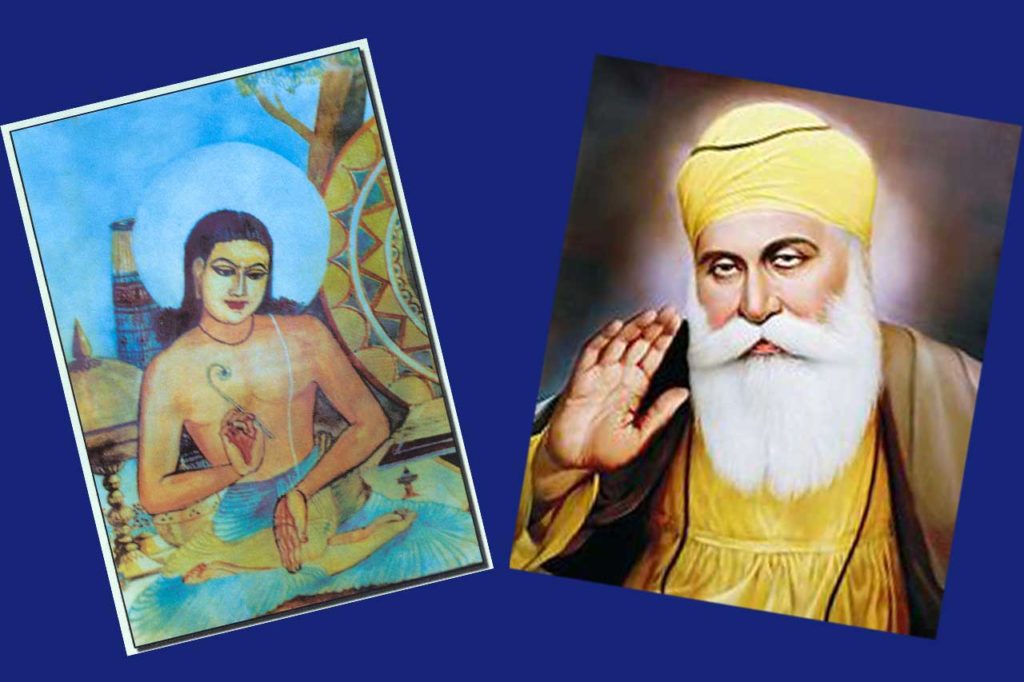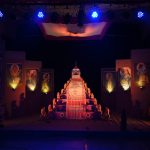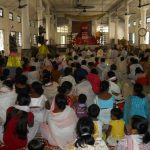Mahapurusha Srimanta Sankaradeva (1449-1568) and Guru Nanak (1469-1539) were both leading lights of medieval Bhakti movement in Bharatavarsha. They both left permanent marks on the society in the sub-continent in both religious and cultural spheres. There are many similarities in the religious principles preached by these two great social reformers. Both were born in an era tormented by social strives and massive appropriation by the Brahmin priests that had left the common people pauperized and devastated. Tantric rituals had distorted and degraded moral values in the society. It was then that these saints came as messiah, who redeemed the people at large from the torment they had been suffering from. They showed the way out from the evils eating the society. Both preached egalitarian ideology and inexpensive methods of religious worship so as to weed out middle-men from the realm of religion. There are some really uncanny and fascinating similarities between the lives of Mahapurusha Srimanta Sankaradeva and Guru Nanak that surprise us. Both were trail-blazers of new movements. Their preachings have mobilized people in millions on the path of virtue over the centuries.
Let us examine the attitudes of Mahapurusha Srimanta Sankaradeva and Guru Nanak to different religious and cultural issues. Let us start with the issue of pilgrimage, an important aspect in any religion. Both the saints travelled all over India for pilgrimage. Srimanta Sankaradeva went twice and Nanak went four times on pilgrimage, which were termed Udasi. But both of them were quick to point out to their respective followers that pilgrimage was not a means of God-realization. So any travel activity to holy places was only a pious act that helped one acquire exposure to other orders and other devotees; it did not bestow salvation on one. Of course humility restrained them from saying that it was a duty of the saints to visit different places of pilgrimage so as to give opportunity to devotees of all those places to receive their blessings. Saints and devotees cannot be compared by the same parameters. Saints are self-realized souls, whereas the devotees are spiritual strugglers. In fact Srimanta Sankaradeva wrote it explicitly at one place in his magnum opus Kirtan-ghosha that rules did not apply to the extra-ordinary souls. Madhavadeva also said it explicitly in Namghosha that self-realized souls were beyond rules.
The interpretation of both the saints about God is also similar. Both have left it in written records that God is one, eternal, unchanging and that God is truth. The Mul mantra in Sikh religion categorically says that God is one. The full meaning of Mul mantra is as follows :
Ik Onkar (God is One)
Sat Nam ( His name is True)
Kartaa Purakh (He is the Creator)
Nirbhau (He is without fear)
Nirvair (He is inimical to none)
Akal-murat (He never dies)
Ajooni (He is beyond births and deaths)
Saibhang ( He is self illuminated)
Gurprasaad (He is realized by the kindness of the True Guru)
Then the Japji Sahib continues to advise the devotees to chant God’s name as God is the eternal truth. The instruction is ascribed to Guru Nanak.
Jap (Repeat His Name)
Aad sach (He is True in the beginning, before the universe existed)
Jugaad sach (He was True when the ages commenced and has ever been True)
Hai bhi sach (He is also True now)
Nanak hosi bhi sach (Satguru Nanak says that he will be certainly True in the future)
There is not even the slightest difference in this Sikh religious philosophy from that of Srimanta Sankaradeva. Kirtan-ghosha of Srimanta Sankaradeva highlight exactly the above principles. Both Srimanta Sankaradeva and Guru Nanak preached that God’s name destroyed all sins and they prescribed listening to God’s name as a religious exercise. Knowledge about the reality dawn in the devotees automatically in the process of chanting God’s name. Srimanta Sankaradeva and Nanak preached devotion to God and shunned all types of Tantric rituals. Both the saints also believed in rebirths and in the effects of one’s deeds being carried over to subsequent births. God gives the results to devotees in subsequent births according to their deeds in the present lives. While the written records of Mahapurusha Srimanta Sankaradeva’s preachings are contained mainly in Kirtan-ghosha, Guru Nanak’s preachings are contained mainly in Japji-Sahib.
Similarities in the ideologies of both the saints make us strongly feel that they met each other, even though the hagiographies of both the saints are silent on it. Such a meeting was certainly possible because Guru Nanak visited Assam in 1505 as recorded in Puratan Janam Sakhi. He went also to Sadiya and then upto Itanagar in Arunachal Pradesh during that visit. A meeting between the two saints took place in this visit although it was not recorded in the hagiographies. Another earlier meeting was also possible during Srimanta Sankaradeva’s first pilgrimage in 1481-1493 when Guru Nanak was in the age period 12-24 years. The fact that the Sikh Guru entered seriously into the realm of spiritualism almost after this time is a significant fact. May be that was why Guru Nanak came here in 1505 to meet Srimanta Sankaradeva again. This needs further research. The Sikhs of Assam firmly believe that such a meeting actually took place. It is also believed that the two saints discussed the way to counter the Tantric cult, which had led to moral decay in the society. The place of the meeting is generally believed by them to be Damdama Sahib at Dhubri, which we do not find tenable as Srimanta Sankaradeva was staying at Bardowa at that time, busy with guiding his disciples, creating literary and cultural outputs, as well as managing the Bhuyan kingdom. He was also settling down with his second wife Kalindi, whom he had married two years ago in 1503. Moreover in the medieval period inter-kingdom journey was few and far between; in the case of a stalwart and erstwhile ruler (Shiromani Bhuyan) like Srimanta Sankaradeva every major movement was certain to be duly recorded, Dhubri and Bardowa coming under separate kingdoms in those times. So the place of the meeting between the two saints was certainly Bardowa.
Both the saints were very respectful of the devotees. God dwells in every being and the devotee is an expression of God, both the saints said expressly in their writings. They did not give any special treatment to own family members. There is no difference of caste in both the orders. Egalitarianism in the society is a characteristic that binds both Assamese and Sikh societies, thanks to these two saints. This highest status given to the devotees in either orders make them very similar. Devotees were supreme for both Mahapurusha Srimanta Sankaradeva and Guru Nanak. This philosophy was embedded firmly in the activities of both the devotional orders. It is seen in the immense respect offered to the devotees. They sit equally in Namghar and Gurudwara. Devotees also dine together in both the orders. In the Sikh religion founded by Guru Nanak, the community feast is known as Langar. In Eka Sarana Nama Dharma preached by Srimanta Sankaradeva, devotees take Prasada and food equally. The ardent followers of the Sikh religion, who dedicate themselves full time are known as Khalsa just like the Kevaliya Bhakat in Eka Sarana Nama Dharma. Both these two groups are celibate. However celibacy is not imperative in either orders. In fact both the Gurus were householders themselves. It may be mentioned that all the followers of Eka Sarana Nama Dharma taken together are called Mahapurushiya, just as all the followers of Guru Nanak taken together are called the Sikhs. Both the householder devotees and celibate devotees are entitled to the epithets Mahapurushiya and Sikh respectively in the two orders.
Even more significant is the fact that both the orders give importance to scriptures as symbol of God rather than any idol or image. Both the saints categorically said that chanting God’s name was superior to worshipping idols. In the Eka Sarana Nama Dharma the holy book Bhagavata or its summary Gunamala (1552) is kept in the altar as representative of God. In the Sikh order the holy book Sri Guru Granth Sahib (1604) is kept in the altar. It is because both the orders believe in formless supreme entity. Interestingly this formless supreme entity is described by the same name in both the orders. Some such names are Krishna, Vasudeva, Hari etc. The character of lord Krishna was very important for both the saints. Both of them highlighted the life of lord Krishna in Vrindavana. Eulogy of lord Krishna by the Gopis, Indra and Brahma were underscored by both. In both the orders Guru acts as a guide for the devotees to realize God, who resides within.
Just as Srimanta Sankaradeva was very liberal, Nanak also was very liberal. This is reflected in the holy book of the Sikhs, Sri Guru Granth Sahib. It set a new standard of liberalism by incorporating in it the writings of 27 Hindu saints, 3 Muslim saints in addition to 6 of their own Gurus. Not only that, music also is a common feature in both the orders. The scriptures of both the orders were sung by the devotees to the tune of different Ragas. Music was indispensable for the medieval saints. Even now the legacy continues, the followers of both the orders performing their prayers in musical ways.
The Assam connection of the Sikh Gurus continued even after Guru Nanak. The ninth Sikh Guru Teg Bahadur came to Assam in 1669 along with the Mughal General Ram Singha as his spiritual guide. Ram Singha was on an expedition to Assam with 30,000 infantry, 15,000 archers, 18,000 Turkish cavalry, 5,000 gunners, over 1000 cannons besides a large flotilla of boats. Teg Bahadur set up a Gurudwara known as Damdama Sahib at Dhubri during this visit. He earned the respect of people in the Brahmaputra valley in this trip. The kings of Tripura and Jaintia kingdom paid respect to him. The feeling was mutual. The Sikh soldiers too were very fond of Assam. The followers of Sikh religion had great affinity to this picturesque state in Brahmaputra valley because of the similarity between the two Bhakti orders which evolved almost simultaneously in the medieval era.
Many Sikh soldiers who came here on different such expeditions therefore preferred to stay back. Two more such groups came under the Generals Kumedan Singh and Chaitanya Singh. Some of these Sikhs settled at the village Barkola near Nagaon. Others settled at Dhubri, Goalpara etc. Their descendants, especially those in Barkola have completely aligned themselves with the mainstream society of Assam. The egalitarian ideology of Mahapurusha Srimanta Sankaradeva have enabled these Sikh people to integrate with the Assamese society. It became possible for them to respond because egalitarian ideology is there in Guru Nanak too. Both the Namghar of the Eka Sarana Nama Dharma and the Gurudwara of the Sikh religion are open to all people. This liberalism is the most important feature in both the orders. That is why the Assamese Sikhs are full of humility and kindness. Crime is almost totally absent among them. They have also enriched the Assamese literature over the years. They are an incomparable bridge between two communities – the Sikhs and the Mahapurushiyas.
Acknowledgement :
This article was earlier published in the website www.sankaradeva.com




